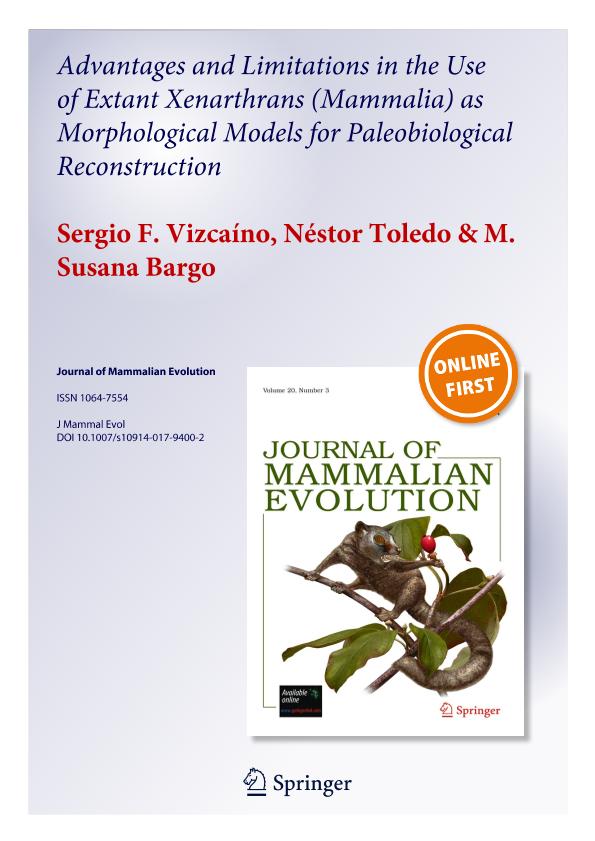Mostrar el registro sencillo del ítem
dc.contributor.author
Vizcaíno, Sergio Fabián

dc.contributor.author
Toledo, Néstor

dc.contributor.author
Bargo, María Susana

dc.date.available
2019-03-22T15:54:10Z
dc.date.issued
2018-12
dc.identifier.citation
Vizcaíno, Sergio Fabián; Toledo, Néstor; Bargo, María Susana; Advantages and Limitations in the Use of Extant Xenarthrans (Mammalia) as Morphological Models for Paleobiological Reconstruction; Springer; Journal of Mammalian Evolution; 25; 4; 12-2018; 495-505
dc.identifier.issn
1064-7554
dc.identifier.uri
http://hdl.handle.net/11336/72285
dc.description.abstract
Extant species of Xenarthra represent a severely restricted sample of the total diversity achieved by the group. Given their shared history, the extant representatives of the three major groups of xenarthrans (Cingulata, Folivora, and Vermilingua) provide a valuable basis for paleobiological inference. However, many extinct taxa are morphologically so dissimilar from their extant relatives that they suggest very different ways of life. In these cases, extinct forms do not have modern models within the group and the application of a simplistic and strict approach can produce nonsensical reconstructions. In this contribution, we evaluate the limitations of the use of extant xenarthrans as morphological models for paleobiological reconstructions. A database of linear dimensions of the appendicular skeleton of extant and extinct xenarthrans and other mammals (marsupials, carnivorans, rodents, primates, perissodactyls, artiodactyls, and proboscideans) was constructed. Exploratory analyzes were performed on general morphometric similarity between existing and extinct xenarthrans (PCA) and the accuracy of body mass estimates of extinct xenarthrans based on their close relatives and other mammals (simple and multiple linear regressions) were tested. Extinct xenarthrans occupy similar relative positions in the morphospaces as extant mammals other than their closest relatives. Most allometric equations, particularly those based only on xenarthrans, produced remarkable underestimates. This can be explained by dimensional differences (up to four orders of magnitude) and shape differences between most of the extinct and extant xenarthrans. This does not invalidate actualism and the use of analogues, but suggests the need to apply other approaches, such as mechanics, that address form-function relationships but are not necessarily based on known biological comparators.
dc.format
application/pdf
dc.language.iso
eng
dc.publisher
Springer

dc.rights
info:eu-repo/semantics/openAccess
dc.rights.uri
https://creativecommons.org/licenses/by-nc-sa/2.5/ar/
dc.subject
Actualism
dc.subject
Form-Function
dc.subject
Paleobiology
dc.subject
Xenarthra
dc.subject.classification
Meteorología y Ciencias Atmosféricas

dc.subject.classification
Ciencias de la Tierra y relacionadas con el Medio Ambiente

dc.subject.classification
CIENCIAS NATURALES Y EXACTAS

dc.title
Advantages and Limitations in the Use of Extant Xenarthrans (Mammalia) as Morphological Models for Paleobiological Reconstruction
dc.type
info:eu-repo/semantics/article
dc.type
info:ar-repo/semantics/artículo
dc.type
info:eu-repo/semantics/publishedVersion
dc.date.updated
2019-03-15T18:24:08Z
dc.journal.volume
25
dc.journal.number
4
dc.journal.pagination
495-505
dc.journal.pais
Alemania

dc.journal.ciudad
Berlin
dc.description.fil
Fil: Vizcaíno, Sergio Fabián. Consejo Nacional de Investigaciones Científicas y Técnicas. Centro Científico Tecnológico Conicet - La Plata; Argentina. Universidad Nacional de La Plata. Facultad de Ciencias Naturales y Museo. División Paleontología Vertebrados; Argentina
dc.description.fil
Fil: Toledo, Néstor. Consejo Nacional de Investigaciones Científicas y Técnicas. Centro Científico Tecnológico Conicet - La Plata; Argentina. Universidad Nacional de La Plata. Facultad de Ciencias Naturales y Museo. División Paleontología Vertebrados; Argentina
dc.description.fil
Fil: Bargo, María Susana. Consejo Nacional de Investigaciones Científicas y Técnicas. Centro Científico Tecnológico Conicet - La Plata; Argentina. Universidad Nacional de La Plata. Facultad de Ciencias Naturales y Museo. División Paleontología Vertebrados; Argentina. Provincia de Buenos Aires. Gobernación. Comisión de Investigaciones Científicas; Argentina
dc.journal.title
Journal of Mammalian Evolution

dc.relation.alternativeid
info:eu-repo/semantics/altIdentifier/url/http://link.springer.com/10.1007/s10914-017-9400-2
dc.relation.alternativeid
info:eu-repo/semantics/altIdentifier/doi/https://doi.org/10.1007/s10914-017-9400-2
Archivos asociados
